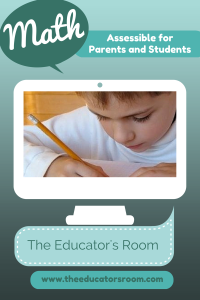 I saw a post on Facebook this week about “Common Core Math.” The idea of the post was if you add 4 apples and 5 oranges you will get an orange haired monkey. Sigh! There is not a perfect curriculum and I don’t believe we will ever know the motivation behind the standards, but they are asking our children to think. The new math standards ask students to apply their knowledge and explain their thinking. We are moving beyond rote memorization and following a method into deeper levels of knowledge. Change is always hard.
I saw a post on Facebook this week about “Common Core Math.” The idea of the post was if you add 4 apples and 5 oranges you will get an orange haired monkey. Sigh! There is not a perfect curriculum and I don’t believe we will ever know the motivation behind the standards, but they are asking our children to think. The new math standards ask students to apply their knowledge and explain their thinking. We are moving beyond rote memorization and following a method into deeper levels of knowledge. Change is always hard.
In my fourth grade classroom we have just finished our unit on addition and subtraction of large numbers. From our standards, “The students will use place value understanding and properties of operations to perform multi-digit arithmetic. The students will fluently add and subtract multi-digit whole numbers using the standard algorithm.” We introduced this concept with base-10 blocks and moved students through methods until they were using mental math and compact “standard” method. While this is scary for parents, our job as educators is to teach our kids and communicate with parents. An important process in the classrooms is to let parents know what you are doing.
“Common core math” is a two-part process. The first part is asking students to explain their thinking and apply knowledge in mathematics. Students moved from Base-10 blocks to using a number line to expanded form to all-partials and finally to compact “standard” method. Some students move through the first three methods quickly. It is interesting, however, to see how place value is applied. And as students increase their knowledge of place value and understand beyond having memorized a process, they become efficient and accurate. Check out my earlier article about these crazy methods we used. The unit test is tomorrow, but having done a formative check today I have 21/24 students adding and subtracting large numbers. They are also able to explain what they are thinking. I worked with the other 3 today so we shall see what tomorrow brings.
The second part of this process is parents. School has changed. It is no longer closed classroom doors with an occasional field trip to go out into the world. It is a community of learners who bring the world into the classroom every day. Not only has technology changed classrooms, teaching styles and instructional strategies are different as well. Parents are an important player in the educational game and keeping them in the loop of your classroom is important. I use social media including Facebook and Twitter and have long ago replaced the old newsletter with a blog. These resources allow me to give parents insight into my classroom. I show examples of student work and activities we are doing. Inviting parents into our classroom is done simply with a few online tools.
The best part about our online community is video tutorials. My students create videos using Educreations (screenchomp is a great lower elementary app). This allows parents to see what is happening and have a resource for helping with homework or studying at home. The methods we are using are new to parents. One-on-one at home, with questions and comments being interjected from the confused parent, it is often difficult for a fourth grader to explain what is happening. Posting our videos online allow students to have examples to share and they also allow parents a resource for helping. We ask parents to support our learning, it is our responsibility to give them the tools just as we do our students.
Common core is not a perfect curriculum. Having been in education for almost 20 years, however, I have seen my students knowledge grow because they are being asked to think. Many of my students are able to compute multi-digit numbers quickly and accurately in their heads. They understand place value and can have conversations about numbers. This deeper level of knowledge means they are able to apply thinking. This will allow them to transfer knowledge. Curriculum will continue to change. But asking students to think and communicating with parents about how they are thinking will only provide stronger experiences in classrooms. So get out and create so videos of the fabulous work you are doing. How do you show parents what your kids are thinking?




